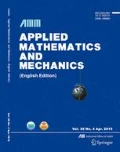Abstract
A new perturbation-like technique called linearization and correction method is proposed. Contrary to the traditional perturbation techniques, the present theory does not assume that the solution is expressed in the form of a power series of small parameter. To obtain an asymptotic solution of nonlinear system, the technique first searched for a solution for the linearized system, then a correction was added to the linearized solution. So the obtained results are uniformly valid for both weakly and strongly nonlinear equations.
Similar content being viewed by others
References
LIU Gao-lian. New research directions in singular perturbation theory: artificial parameter approach and inverse-perturbation technique[A]. In: CHENG Chang-jun, DAI Shi-qiang, LIU Yu-lu Eds.Conf of 7th Modern Mathematics and Mechanics[C]. Shanghai: Shanghai University Press, 1997, 47–53. (in Chinese)
HE Ji-huan. Homotopy perturbation technique[J].Computer Methods in Applied Mechanics and Engineering, 1999,178(3/4):257–262.
HE Ji-huan. A coupling method of homotopy technique and perturbation technique for nonlinear problems[J].International J Nonlinear Mechanics, 2000,35(1):37–43.
HE Ji-huan. Some new approach to Duffing equation with strongly & high order nonlinearity (II) parameterized perturbation technique[J].Communications in Nonlinear Science & Numerical Simulation, 1999,4(1):81–82.
HE Ji-huan. Modified straightforward expansion[J].Meccanica, 1999,34(4):287–289.
HE Ji-huan. A new perturbation technique which is also valid for large parameters[J].Journal of Sound and Vibration, 1999,229(5):1257–1263.
HE Ji-huan. A review on some new recently developed nonlinear analytical techniques[J].Int J Nonlinear Sciences & Numerical Simulation, 2000,1(1):51–70.
Nayfeh A H.Introduction to Perturbation Techniques[M]. London: John Wiley & Sons, 1981.
HE Ji-huan. Modified Lindsted-Poincare Methods for some strongly nonlinear oscillations, part I: Expansion of a constant[J].Int J Nonlinear Mechanics, 2002,37(2):309–314.
HE Ji-huan. Modified Lindsted-Poincare Methods for some strongly nonlinear oscillations, part II: A new transformation[J].Int J Nonlinear Mechanics, 2002,37(2):315–320.
HE Ji-huan. Variational iteration method — a kind of nonlinear analytical technique: some examples [J].Int J Nonlinear Mechanics, 1999,34(4):699–708.
Mickens R E.An Introduction to Nonlinear Oscillations[M]. Cambridge: Cambridge University Press, 1981.
Hagedorn P.Nonlinear Oscillations[M]. Wolfram Stafler, transl. Oxford: Clarendon Press, 1981. (English version)
Author information
Authors and Affiliations
Additional information
Contributed by HE Ji-huan
Biography: HE Ji-huan (1965-), Professor, Doctor; Editor-in-chief of International Journal of Nonlinear Sciences and Numerical Simulation (Freund Publishing House Ltd, UK), and International Journal of Nonlinear Modelling in Science and Engineering (Cambridge International Science Publishing, UK)
Rights and permissions
About this article
Cite this article
Ji-huan, H. Linearization and correction method for nonlinear problems. Appl Math Mech 23, 241–248 (2002). https://doi.org/10.1007/BF02438331
Received:
Revised:
Issue Date:
DOI: https://doi.org/10.1007/BF02438331




